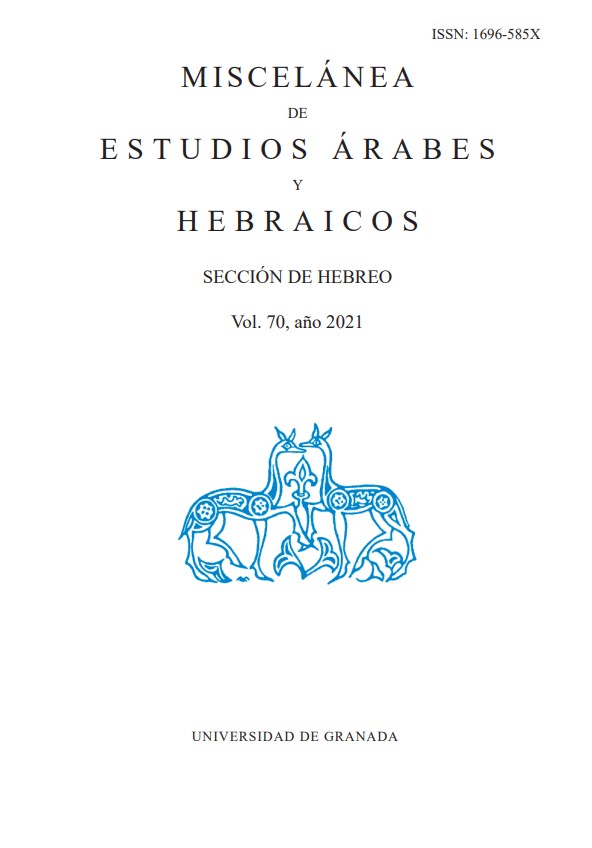«Lo que ha sido escrito en la frente, el ojo lo debe ver»: Un escritor judeoárabe entre Bagdad y el campo de refugiados en Israel
DOI:
https://doi.org/10.30827/meahhebreo.v70.22580Palabras clave:
Literatura árabe, cultura judeo-árabe, Shalom Darwish, judíos iraquíes, BagdadResumen
Desde el período preislámico, los judíos participaron en la producción literaria en árabe como parte integrante de la sociedad arabo-islámica. Conocemos a poetas judíos prominentes como al-Samawʾal ibn ʿᾹdiyāʾ en el siglo VI d.C. e Ibrāhīm ibn Sahl en al-Andalus en el siglo XIII. Durante la primera mitad del siglo XX, la literatura árabe en fuṣḥā (árabe estándar) escrita por judíos fue testigo de un gran resurgimiento, especialmente en Irak y Egipto, pero este resurgimiento se vio interrumpido a causa del sionismo y el nacionalismo árabe, y el conflicto entre ambos. En la actualidad estamos asistiendo a la desaparición de la literatura árabe escrita por judíos. La lengua árabe se conservará entre los judíos principalmente como una herramienta del ejército y los sistemas de inteligencia, como se resume en el dicho «conoce a tu enemigo», en lugar de ser un medio para la coexistencia y el conocimiento del otro. El artículo se concentra en las actividades literarias de uno de los autores judíos iraquíes con más talento, Shalom Darwīsh (1913-1997), cuyo prometedor futuro en el campo de la literatura árabe fue interrumpido tras la exclusión antes mencionada de los judíos de la arabidad.
Descargas
Citas
Agassi, Eliyahu (ed.) (1959) Fī Mahrajān al-Adab. Tel-Aviv: Maṭba‘at Davar.
Aḥmad, ‘Abd al-Ilāh (1969) Nash’at al-Qiṣṣa wa-Taṭawwuruhā fī al-‘Irāq 1908-1939. Baghdad, Maṭba‘at Shafīq.
Al-Musawi, Muhsin Jassim (2006) Reading Iraq: Culture and Power in Conflict. London and New York, I.B. Tauris.
Al-Mutanabbī, Abū al-Ṭayyib (n.d.) Dīwān al-Mutanabbī. Beirut: al-Maktaba al-Thaqāfiyya.
Al-Qāḍī, Muḥammad (1993) al-Ẓāhir wa-l-Bāṭin fī Kitāb al-Ayyām: Baḥth fī al-Tab’īr. In: Mā’wiyyt Ṭāhā Ḥusayn: Waqā’i‘ Nadwat Bayt al-Ḥikma bi-Qarṭāj 27 wa-28 June 1990. Tunis: al-Majma‘ al-Tunisī li-l-‘Ulūm wa-l-Ādāb wa-l-Funūn, Bayt al-Ḥikma: 207-232.
Al-Ṭālib, ‘Umar (1976) The Characteristics of the Iraqi Short Story after the Second World War till July 1958. al-Aqlām: 35-46 (in Arabic).
Al-Ṭālib, ‘Umar (1979) al-Qiṣṣa al-Qaṣīra al-Ḥadītha fī al-‘Irāq. Mosul: Mu’assasat Dār al-Kutub li-l-Ṭibā‘a wa-l-Nashr.
Baṣrī, Mīr (1993) A‘lām al-Yahūd fī al-‘Irāq al-Ḥadīth. Jerusalem, Rābiṭat al-Jāmi‘iyyīn al-Yahūd al-Nāziḥīn min al-‘Irāq.
Blanc, Haim (1963) Communal Dialects in Baghdad. Cambridge, MA: Harvard University Press.
Carter, B. L. (1986) The Copts in Egyptian Politics. London, Croom Helm.
Chetrit, Sami Shalom (2004) Ha-Ma’avak ha-Mizraḥī be-Yisra’el: Bein Dikuy le-Shiḥrūr, Bein Hizdahūt le-Alternativa, 1948-2003. Tel-Aviv: Am Oved.
Darwīsh, Shalom (1931) Ba‘da Mawt Akhīhi. Baghdad: Maṭba‘at al-Ma‘ārif.
Darwīsh, Shalom (1941) Aḥrār wa-‘Abīd. Baghdad: Maṭba‘at al-Rashīd.
Darwīsh, Shalom (1948) Ba‘ḍ al-Nās. Baghdad: Sharikat al-Tijāra wa-l-Ṭibā‘a al-Maḥdūda.
Darwīsh, Shalom (1976) Bayḍat al-Dīk. Jerusalem: Majallat al-Sharq.
Darwīsh, Shalom (1986) Phraim! Phraim! [Ephraim! Ephraim!]. Tel-Aviv: Bimat-Kedem le-Sifrut.
Ghanimah, Yusuf Rizk-Allah (1998) A Nostalgic Trip into the History of the Jews of Iraq, translated by A. Dallal, Lanham. New York and Oxford, University Press of America.
Ghunayma, Yūsuf Rizq Allāh (1924) Nuzhat al-Mushtāq fī Ta’rīkh Yahūd al-‘Irāq. Baghdad, Maṭba‘at al-‘Irāq.
Ḥusayn, Ṭāhā (n.d. [1929]) al-Ayyām, (vol. I). Cairo : Dār al-Ma‘ārif.
Marmorstein, Emile (1964) An Iraqi Jewish Writer in the Holy Land. The Jewish Journal of Sociology 6.1: 92-100.
Meir-Glitzenstein, Esther. (2002). Our Dowry: Identity and Memory Among Iraqi Immigrants in Israel. Middle Eastern Studies 38.2: 165-186.
Moreh, Shmuel (1973) Ḥibure Yehūdīm ba-Lashon ha-‘Aravit 1863-1973. Jerusalem: The Ben-Zvi Institute.
Moreh, Shmuel (1981) al-Qiṣṣa al-Qaṣīra ‘Inda Yahūd al-‘Irāq. Jerusalem: Magnes Press.
Mudhi, Miklif Hamad (1988) The Origin and Development of the Iraqi-Jewish Short Story from 1922 to 1972. Ph.D. Thesis, University of Exeter.
Rejwan, Nissim (1985) The Jews of Iraq, 3000 Years of History and Culture. London: Weidenfeld & Nicholson.
Rejwan, Nissim (2004) The Last Jews in Baghdad: Remembering a Lost Homeland. Austin, University of Texas Press.
Shamosh, Amnon (1979) Kane ve-Kinnamon. Ramat-Gan: Massada.
Shā’ul, Anwar (1980) Qiṣṣat Ḥayātī fī Wādī al-Rāfidayn. Jerusalem, Rābiṭat al-Jāmi‘iyyīn al-Yahūd al-Nāziḥīn min al-‘Irāq.
Shenhav, Yehuda (2006) The Arab Jews: A Postcolonial Reading of Nationalism, Religion, and Ethnicity. Stanford: Stanford University Press.
Shiblak, Abbas (1986) The Lure of Zion: The Case of the Iraqi Jews. London, Al Saqi Books.
Snir, Reuven (1994) The ‘World Upsidedown’ in Modern Arabic Literature: New Literary Renditions of an Antique Religious Topos. Edebiyât 5.1: 51-75.
Snir, Reuven (2005) ‘Arviyyūt, Yahadūt, Tsiyonūt: Ma’avak Zehūyot ba-Yetsira shel Yehūde ‘Iraq. Jerusalem, the Ben-Zvi Institute.
Snir, Reuven (2015) Who Needs Arab-Jewish Identity? Interpellation, Exclusion, and Inessential Solidarities. Leiden: Brill.
Snir, Reuven (2019) Arab-Jewish Literature: The Birth and Demise of the Arabic Short Story. Leiden: Brill.
Snir, Reuven (2020) «Washing Away the Shame»: A Forgotten Arab-Jewish Author as a Pioneer against Honor Killing, Shofar ― An Interdisciplinary Journal of Jewish Studies 38.1: 109-145.
Stern, S.M. (1963) Arabic Poems by Spanish-Hebrew Poets. In: M. Lazar (ed.), Romanica et Occidentalia Etudes dédiées à la mémoire de Hiram Peri (Pflaum). Jerusalem: Magnes Press: 254-263.
Descargas
Publicado
Cómo citar
Número
Sección
Licencia

Este obra está bajo una licencia de Creative Commons Reconocimiento-NoComercial 4.0 Internacional.












